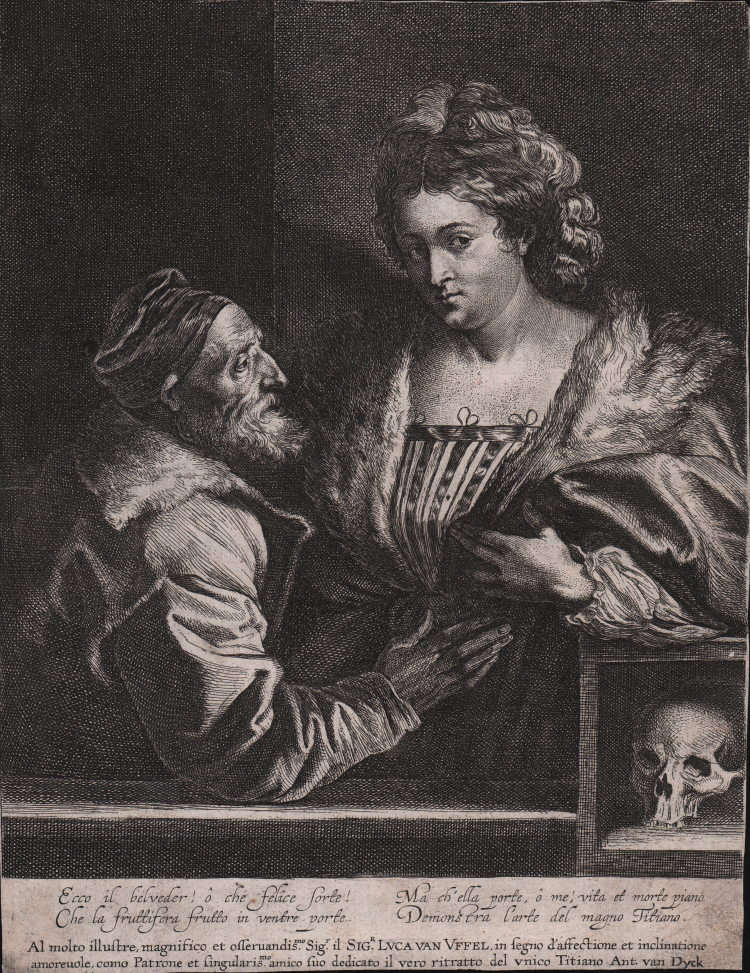




| Reference: | S45166 |
| Author | Anton van DYCK |
| Year: | 1641 ca. |
| Measures: | 225 x 295 mm |



| Reference: | S45166 |
| Author | Anton van DYCK |
| Year: | 1641 ca. |
| Measures: | 225 x 295 mm |
Etching and engraving, before 1641, lettered: "Ecco il belveder! ô che felice sorte! / Che la fruttifera in ventre porte / Ma ch'ella porte, ô me; vita et morte piano / Demonstra l'arte del magno Titiano.".
Dedication: "Al molto illustre, magnifico et offerunadis.mo Sig.r il SIG.R LUCA VAN UFFEL, in segno d'affectione et inclinatione / amoreuole, com Patrone et singularis.mo amico suo dedicato il vero ritratto del unico Titiano Ant. van Dyck".
A very good impression of the third state of four, before the address of A. Bonenfant.
The print, depicting Titian and his mistress, is probably derived from a drawing by Vecellio. However, the question is far from clear and the source of the enigmatic design is not yet resolved. The print is etched in etching by Anton van Dyck and finished in engraving by his pupil Lucas Vorsterman (1595-1675).
The first state impressions are in the British Museum, Rijksmuseum, and in the Cabinet Edmond de Rothschild, Musée du Louvre.
A fine impression, printed on contemporary laid paper, trimmed to the palltemark, expert repairs at the lower corners, otherwise very good condition.
Bibliografia
Depauw & G. Luijten, 'Anthony van Dyck as a printmaker', ex. cat. Museum Plantin-Moretus/Stedelijk Prentenkabinet, Antwerp and Rijksmuseum, Amsterdam, 1999, no. 32; New Hollstein (Dutch & Flemish) / The New Hollstein: Dutch and Flemish etchings, engravings and woodcuts 1450-1700 (628.III); Hollstein / Dutch and Flemish etchings, engravings and woodcuts c. 1450-1700 (210); Mauquoy-Hendrickx 1991 / L'Iconographie d'Antoine Van Dyck, Catalogue raisonné (B.III).
Anton van DYCK (Anversa 1599 – Londra 1642)
|
After Rubens, van Dyck was the leading Flemish painter in the first half of the seventeenth century. Van Dyck assisted Rubens in his studio, and Rubens referred to him as 'the best of my pupils'. With the encouragement of the Earl of Arundel, Van Dyck arrived in England in 1620. After a year, he left for Italy where he toured, painted aristocratic portraits in Genoa and elsewhere, and returned to Flanders in 1627. Based in Antwerp, van Dyck painted portraits, mythological and religious scenes for Europe's collectors, including Charles I of England. By 1632, van Dyck was in England as court artist to Charles I, who knighted him. In return, he produced the most memorable portraits of Charles I, his family and courtiers. It was in Italy that van Dyck acquired the refined and elegant picture style that characterizes his work, particularly his English portraits. The proud, slender figures, elegantly dressed in rich costumes, typify the traditional image of the cavalier court of Charles I.
|
Anton van DYCK (Anversa 1599 – Londra 1642)
|
After Rubens, van Dyck was the leading Flemish painter in the first half of the seventeenth century. Van Dyck assisted Rubens in his studio, and Rubens referred to him as 'the best of my pupils'. With the encouragement of the Earl of Arundel, Van Dyck arrived in England in 1620. After a year, he left for Italy where he toured, painted aristocratic portraits in Genoa and elsewhere, and returned to Flanders in 1627. Based in Antwerp, van Dyck painted portraits, mythological and religious scenes for Europe's collectors, including Charles I of England. By 1632, van Dyck was in England as court artist to Charles I, who knighted him. In return, he produced the most memorable portraits of Charles I, his family and courtiers. It was in Italy that van Dyck acquired the refined and elegant picture style that characterizes his work, particularly his English portraits. The proud, slender figures, elegantly dressed in rich costumes, typify the traditional image of the cavalier court of Charles I.
|